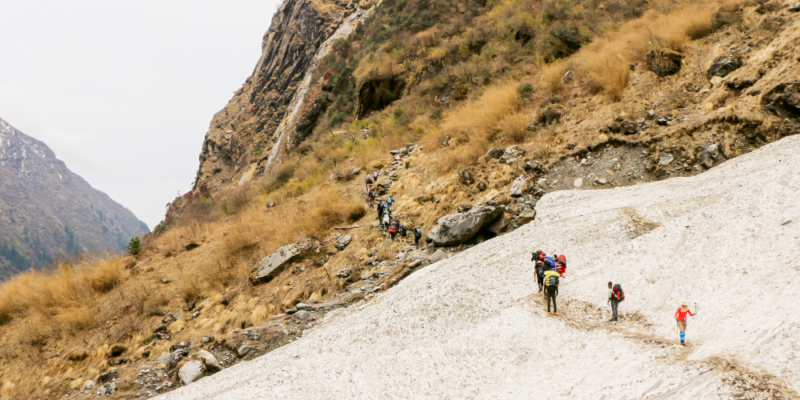
Trekking is often synonymous with adventure, nature, and a quest for the unknown. Among the numerous trekking destinations in India, the Nag Tibba trek stands out for its unique blend of serene beauty, thrilling paths, and cultural richness. Located in the Garhwal region of Uttarakhand, the Nag Tibba trek is an ideal getaway for both seasoned trekkers and beginners. My journey to Nag Tibba was an experience that etched unforgettable memories in my heart, and I am thrilled to share this exhilarating adventure with you.
Nag Tibba Trek
Our adventure began from Dehradun, the capital city of Uttarakhand. We embarked on a scenic drive early in the morning, with the crisp mountain air filling our lungs and the anticipation of the trek ahead. The drive to Pantwari, the base village for the Nag Tibba trek, took about four hours. The road meandered through picturesque landscapes, lush green valleys, and quaint villages, providing a visual treat that kept us mesmerized.
Pantwari, a quaint village nestled in the hills, welcomed us with its rustic charm. The villagers, with their warm smiles and friendly demeanor, made us feel right at home. We took some time to explore the village, capturing glimpses of traditional Garhwali life. The simple yet vibrant lifestyle of the villagers was a refreshing change from the hustle and bustle of city life.
Setting Off: The Ascent Begins
After a brief rest and a hearty breakfast, we geared up for the trek. The trail from Pantwari to Nag Tibba Base Camp is a moderate climb, making it suitable for beginners. Our guide, a local from the village, led the way, sharing interesting anecdotes and stories about the region.
The initial part of the trail was a gentle ascent through terraced fields and small hamlets. The chirping of birds and the rustling of leaves created a soothing symphony, making the walk delightful. As we ascended further, the terrain became steeper, and the forest canopy grew denser. The path was lined with oak and rhododendron trees, their leaves forming a natural carpet beneath our feet.
En Route: The Scenic Beauty
One of the highlights of the Nag Tibba trek is the breathtaking scenery that unfolds at every turn. As we climbed higher, the panoramic views of the surrounding mountains and valleys became more and more spectacular. The snow-capped peaks of the Gangotri and Bandarpoonch ranges stood majestically against the clear blue sky, creating a picture-perfect backdrop.
We took frequent breaks to soak in the beauty and capture the moments with our cameras. Each spot seemed more beautiful than the last, compelling us to pause and admire nature’s artistry. The cool mountain breeze and the refreshing shade of the trees provided much-needed respite, allowing us to recharge before continuing our ascent.
The Flora and Fauna: A Natural Wonderland
The Nag Tibba trek is a haven for nature lovers, offering a rich tapestry of flora and fauna. The forests are teeming with a variety of plant species, including oak, rhododendron, and pine trees. During the spring season, the rhododendron trees burst into bloom, painting the landscape in hues of red and pink.
The region is also home to diverse wildlife. While trekking, we were fortunate to spot a variety of birds, including the Himalayan Monal, which is the state bird of Uttarakhand. The forests echoed with the calls of these vibrant birds, adding a melodic soundtrack to our journey. Occasionally, we spotted langurs swinging through the trees, adding an element of excitement to our trek.
Reaching Base Camp: A Night Under the Stars
After several hours of trekking, we finally reached the Nag Tibba Base Camp. Nestled in a clearing amidst the dense forest, the base camp offered a serene and tranquil setting. We set up our tents and gathered around for a warm meal prepared by our guide. The simplicity of the meal, coupled with the surrounding beauty, made it one of the most memorable dining experiences.
As night fell, the sky transformed into a canvas of stars. The Milky Way was visible in all its glory, a sight seldom seen in the city. We spent the evening sharing stories, singing songs, and marveling at the starlit sky. The camaraderie and the shared sense of accomplishment created a bond that would last long after the trek was over.
The Summit Push: Climbing to Nag Tibba
The next morning, we woke up early, eager to reach the summit of Nag Tibba. The final ascent was a challenging climb, but the promise of the views from the top kept us motivated. The trail became steeper and rockier, testing our endurance and determination.
As we neared the summit, the trees gave way to open meadows, and the panoramic views took our breath away. The sight of the Himalayan peaks bathed in the golden glow of the morning sun was a reward beyond words. The sense of achievement and the sheer beauty of the landscape made the arduous climb worthwhile.
At the Summit: A View to Remember
Standing at the summit of Nag Tibba, at an altitude of 9,915 feet, was an exhilarating experience. The 360-degree view of the snow-clad peaks and the sprawling valleys below was awe-inspiring. We could see the Bandarpoonch, Kedarnath, and Gangotri ranges, among others. The sense of being on top of the world was overwhelming, filling us with a profound sense of peace and accomplishment.
We spent some time at the summit, taking in the views and capturing the moments with our cameras. The feeling of the cool breeze on our faces and the sight of the endless expanse of mountains was a memory that would stay with us forever. We offered our prayers at the Nag Tibba temple, which is dedicated to the Serpent God, and sought blessings for a safe descent.
The Descent: Reflecting on the Journey
After basking in the glory of the summit, it was time to start our descent. The journey down was quicker but required careful navigation, especially on the steeper sections. The descent provided a different perspective of the landscape, allowing us to appreciate the beauty from a new angle.
As we made our way back to Pantwari, we reflected on the journey. The trek had not only tested our physical endurance but also our mental strength. It had brought us closer to nature and allowed us to disconnect from the distractions of everyday life. The memories of the trek, the bonds forged, and the stunning vistas were treasures that we carried back with us.
A Glimpse into Local Culture: Interacting with the Garhwali People
One of the most enriching aspects of the Nag Tibba trek was the opportunity to interact with the local Garhwali people. The villagers we met along the way were warm, hospitable, and eager to share their stories and traditions. We learned about their customs, festivals, and the challenges they face living in such remote areas.
The simplicity and resilience of the Garhwali people were truly inspiring. Their deep connection with nature and their contentment with a simple life offered valuable lessons. We also had the chance to taste local delicacies, which were prepared with fresh, organic ingredients. These interactions added a cultural dimension to our trekking experience, making it all the more meaningful.
Practical Tips for the Nag Tibba Trek
For those planning to embark on the Nag Tibba trek, here are some practical tips to ensure a smooth and enjoyable journey:
1. Fitness and Preparation
While the Nag Tibba trek is considered moderate, it is essential to be in good physical condition. Regular exercise and cardio workouts in the weeks leading up to the trek can help build stamina and endurance.
2. Packing Essentials
Pack light but ensure you have all the essentials. This includes comfortable trekking shoes, warm clothing, rain gear, a sturdy backpack, water bottles, and energy snacks. A first-aid kit and any personal medication are also crucial.
3. Acclimatization
Allow yourself some time to acclimatize to the altitude, especially if you are coming from a lower elevation. This can help prevent altitude sickness and ensure a more enjoyable trek.
4. Respect Nature
Practice responsible trekking by not littering and respecting the natural environment. Carry your waste with you and dispose of it properly once you return to the base village.
5. Hire a Guide
Hiring a local guide can greatly enhance your trekking experience. They can provide valuable insights into the region, ensure your safety, and help navigate the trails.
Conclusion: A Journey to Cherish
The Nag Tibba trek was an unforgettable adventure that left an indelible mark on my heart. The beauty of the landscape, the thrill of the climb, and the sense of accomplishment at reaching the summit made it a truly enriching experience. The trek taught me the importance of perseverance, the joy of simple pleasures, and the value of connecting with nature.
If you are looking for an escape from the mundane, a journey that challenges you and rewards you in equal measure, the Nag Tibba trek is the perfect choice. It is a journey that will fill you with awe, inspire you, and leave you with memories to cherish for a lifetime.
Embark on the Nag Tibba trek, and let the mountains weave their magic. It is an experience that will stay with you, long after you have descended the peaks and returned to the plains. The memories of the trek, the beauty of the Himalayas, and the camaraderie of fellow trekkers will always hold a special place in your heart.











